Understanding the Role that Off-Tracking Plays in Tractor-Trailer and Large Commercial Motor Vehicle Crashes
Off-tracking happens when a turning vehicle’s rear wheels do not follow the same path as the front wheels. The severity of off-tracking is amplified when longer vehicles, such as box trucks, are involved. It is particularly noticeable when a truck or any vehicle-trailer combination makes a turn at lower speeds.
But Professional Truck Drivers Should Know Better.
Professional truck drivers are trained to account for off-tracking in CDL courses, handbooks, and company driver-training programs. Not all drivers of trucks, buses, or vehicles towing trailers consider off-tracking when navigating turns or curved roadways. Failing to consider off-tracking scenarios, when combined with large truck blind spots or long trailers, can result in serious accidents. Truck drivers may not realize that their vehicles or trailers have impacted others due to their sizes and weights.
The Law Requires Truck Drivers to Demonstrate Off-Tracking Knowledge & Skill
The Federal Motor Carrier Safety Regulations (FMCSR) 49 C.F.R. §383.111(a)(4) specifically outlines off-tracking as one of more than 20 general areas in which all CMV operators are required to have knowledge related to the basic control of a CMV. FMCSR 49 C.F.R. §§383.113(b)(5) and (c)(5) outline CDL applicants’ requirements to demonstrate driving skills for preventing off-tracking problems.
Common Off-Tracking Scenarios
The following outlines common off-tracking scenarios that must be considered when assessing truck crashes and establishing fault in any CMV crash case. The movement of a CMV or trailer can often mislead other drivers due to off-tracking, causing altered perception. A driver’s altered perception can lead to unnecessary reactions like swerving or braking due to fear of a crash. The arrow in the photo below depicts this tractor-trailer driver’s intended path/lane of travel. An approaching or passing motorist might perceive the tractor-trailer as encroaching into another motorist’s lane during the turn.
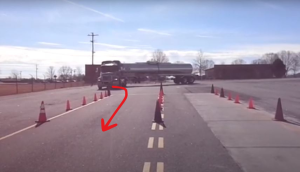
Low-Speed Off-Tracking
Low-speed offtracking typically occurs when a tractor-trailer or combination vehicle turns low-speed left or right. The rear axles of the truck follow a much shallower path than its front steer axles, as depicted below.
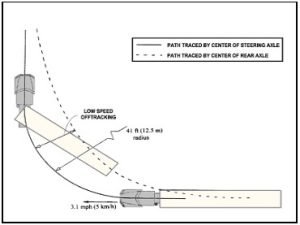
This is why the rear of many tractor-trailers and other large CMVs are equipped with caution stickers warning of “Caution: Wide Right Turns.”
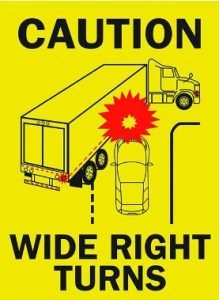
The failure of professional truck drivers to account for off-tracking in low-speed turns can lead to collisions with stationary vehicles, property, or pedestrians. A conscientious CMV operator aware of off-tracking may overcompensate, leading to collisions. Overcompensating or undercompensating can lead to encroaching into another motorist’s lane or right of way. It can also lead to scenarios where the driver must stop in the roadway or dangerously attempt to reverse during natural traffic patterns and traffic flow, which can cause other vehicles to divert course and cause a chain reaction.
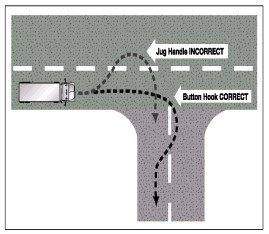
High-Speed Off-Tracking
As depicted in the figure below, high-speed off-tracking occurs when the rear of a truck or a trailer being towed tends to move outward from the truck’s travel path during a turn made at higher speeds. The extent of high-speed off-tracking (i.e., the outward movement of the rear of a truck or its trailer) is a function of many factors, including the speed of the truck, the spacing between axles, the weights and loads of the truck/trailer, the radius of the turn, the geometry of the roadway, and the suspension characteristics of the truck/trailer.
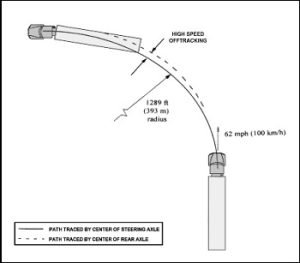
This type of off-tracking scenario oftentimes occurs when tractor-trailers navigate a curve at higher speeds. While the tractor itself may stay within its designated travel lane, the outboard and rear sides of the trailer will tend to drift into the outer travel lanes and encroach upon motorists who are properly within their own designated travel lanes adjacent to the tractor-trailer, oftentimes unbeknownst to the truck driver who may be maintaining his or her tractor in its designated travel lane while its trailer drifts.
Improper Maintenance of Trailers can Exacerbate Off-Tracking Scenarios
Trailer misalignment from use and wear over time can significantly increase off-tracking during turns and roadway curves. Bent axles, frames, potholes, or worn bushings can cause a trailer to go out of alignment and worsen offtracking. This may lead to negligent maintenance or repair claims related to the lack of upkeep of trailer components.
What should I do if I am injured as a result of a Truck or Tractor-Trailer?
If you’ve been in a collision with a CMV or tractor-trailer during a turn, a truck crash lawyer can help assess the cause.
Romano Law Group has a team of experienced commercial motor vehicle and truck crash lawyers, investigators, and staff. We have decades of combined experience handling truck crashes and commercial motor vehicle crash cases involving off-tracking scenarios and considerations. If you or your loved ones have been involved in a collision due to a commercial motor vehicle or tractor-trailer negotiating a turn or a roadway curve, give us a call. Romano Law Group can help by assessing all potential off-tracking considerations that may apply to the pursuit of potential legal remedies you may have.
Authored By Todd Romano

The post What role does off-tracking play in truck crashes? appeared first on Romano Law Group.




